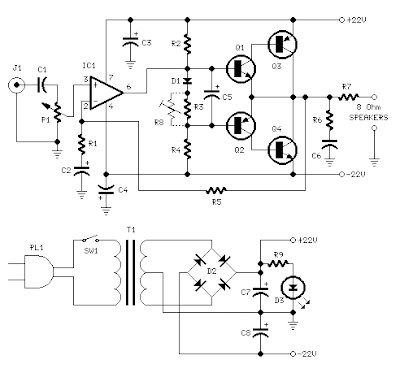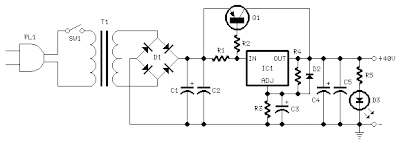Skema Rangkaian Sirkuit pengatur volume digital
Sunday, October 25, 2009

Home » Archives for October 2009
Sunday, October 25, 2009

Posted in: Power Amplifier | | |

Saturday, October 24, 2009

Posted in: Power Amplifier | | |


Saturday, October 17, 2009
Posted in: Power Amplifier | | |
 amateurs all around the world and is still very popular: as a logical consequence, in these years this small amplifier was frequently debated in Audio forums and rumors arose about its quiescent current stability and other topics.
amateurs all around the world and is still very popular: as a logical consequence, in these years this small amplifier was frequently debated in Audio forums and rumors arose about its quiescent current stability and other topics.Posted in: Power Amplifier | | |

Posted in: Power Amplifier | | |

Posted in: skema amplifier | | |
Capacitor discharge of latching relays and rotary filter - Direct current circuitry for sequentially energizing two or more motors or ther load devices, using capacitive discharge to latch in a relay for each load device. During one stage of operation a relatively small voltage is impressed on one lead of a capacitor whose other lead is grounded; a charge is thereby developed in the capacitor. Subsequently a relatively large voltage is impressed on the other lead of the capacitor to direct the charge into the coil of the relay, thereby effecting a relay latching action. The capacitor thereafter isolates the latching circuit from a de-latching circuit; the de-latching circuit is part of a latching circuit for a second relay used to energize a second load device. The invention is particularly useful in sequentially operating electric motors used in self-cleaning engine air cleaners. see full archive at http://www.freepatentsonline.com/4009011.html

 Preamp Parts:
Preamp Parts:
The Power Amplifier section employs only three transistors and a handful of resistors and capacitors in a shunt feedback configuration but can deliver more than 18W into 8 Ohm with <0.08%>
The setup of this amplifier must be done carefully and with no haste:
Posted in: Power Amplifier | | |
The stereo signals coming from the line outputs of the car radio amplifier are mixed at the input and, after the Level Control, the signal enters the buffer IC1A 
Then, a 12dB/octave variable frequency Low Pass filter built around IC1B, Q1 and related components follows, allowing to adjust precisely the low pass frequency from 70 to 150Hz.
Q2, R17 and C9 form a simple dc voltage stabilizer for the input and filter circuitry, useful to avoid positive rail interaction from the power amplifier to low level sections.
Posted in: Car Subwoofer | | |

Copyright 2011 | All Rights Reserved